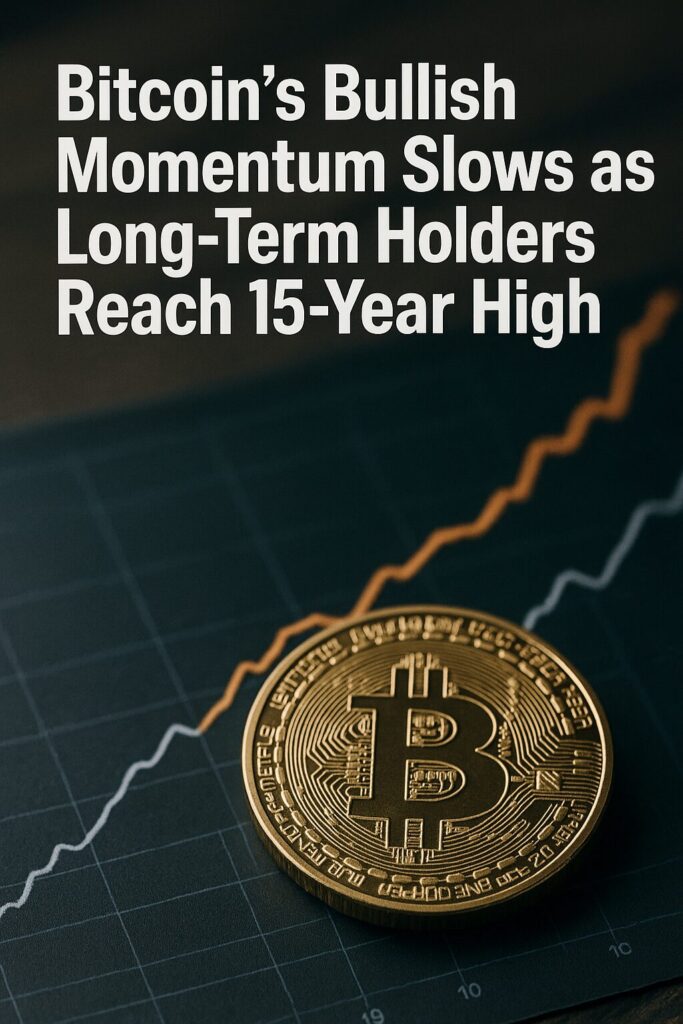
Main Points:
- June 2025 Performance: Bitcoin rose a modest 2.55% in June but failed to clear its May all-time-high of $112,000.
- Long-Term Holder Accumulation: Addresses holding BTC for 155+ days now control 74% of supply, the highest level in 15 years.
- On-Chain Capital Flows Cooling: Quarterly inflows dipped, and the MVRV momentum indicator has flattened, signaling reduced speculative heat.
- Macroeconomic Context: A surprisingly strong U.S. dollar and cooling inflation—contrary to the dollar-debasing narrative—are reshaping crypto sentiment.
- BTC Dominance & Altcoin Underperformance: Bitcoin’s market share climbed to 65%, driven by weaker altcoin demand.
June Market Performance
In June 2025, Bitcoin’s price quietly inched up by 2.55%, closing the month within a $109,000–$112,000 range. Despite this gain, BTC could not breach its May all-time-high of $112,000, indicating the market remains in a consolidation phase rather than an outright breakout. Daily trading volumes slowed, and volatility retreated to historical lows, reflecting both a lack of fresh catalysts and retreating speculative fervor.
Figure 1: June 2025 BTC Performance Table
Metric Value June 2025 Price Change +2.55% May 2025 All-Time High $112,000 End-June 2025 Approx. Closing $109,000 30-Day Volatility (Annualized) ~45% Average Daily Volume (Jun ’25) $35 billion
Surging Long-Term Holder Conviction
One of the most striking takeaways from ARK Invest’s June report is the record accumulation by long-term holders (LTHs). Addresses that have held BTC for 155 days or more now collectively own 74% of the total supply—the highest proportion since 2010. This shift underscores that seasoned investors remain firmly committed to Bitcoin’s store-of-value thesis, even as retail participation wanes.
Figure 2: Long-Term Holder Supply Trend (2018–2025)
Year LTH Supply (%) 2018 62% 2019 65% 2020 68% 2021 70% 2022 71% 2023 72% 2024 73% 2025 74%
This structural supply lock-up limits the available float, potentially amplifying price moves when fresh demand re-emerges. For new entrants, this dynamic raises the bar for meaningful upside without a corresponding increase in capital flows.
On-Chain Momentum Cooling
ARK’s analysis finds that on-chain capital flows into Bitcoin cooled in Q2. The report’s Market-Value-to-Realized-Value (MVRV) momentum indicator—a gauge of speculative over- or under-valuation—has flattened near its two-year moving average. This signals that buying pressure from both retail and institutional traders has eased compared to the frenetic pace seen through much of 2024 and early 2025.
The decline in new buyer addresses, down roughly 15% year-over-year, further buttresses the case for a pause in momentum. As fresh demand weakens, price action may remain range-bound until a clear catalyst—be it a regulatory shift, macro surprise, or major network upgrade—re-ignites bullish conviction.
Macroeconomic Backdrop
1. Resilient U.S. Dollar
Contrary to the prevailing “dollar-debasement” thesis that fueled much crypto optimism, the Trade-Weighted U.S. Dollar Index has strengthened in recent months, buoyed by robust domestic growth and geopolitical safe-haven flows. A strong dollar tends to weigh on dollar-priced assets including Bitcoin, as overseas investors face higher entry costs.
2. Cooling Inflation & Fed Outlook
U.S. inflation has decelerated to 1.5% average CPI between February and May 2025, surprising to the downside. While this undercuts Bitcoin’s narrative as an inflation hedge, it raises hopes that the Federal Reserve may begin rate cuts as early as the September 2025 FOMC meeting. Lower policy rates historically spur risk-asset rallies, including in tech stocks and cryptocurrencies.
3. Housing Market Weakness
The ARK report also flags a growing disconnect between homeowner price expectations and actual home sales, warning of ripple effects on consumer confidence and broader spending. A weakening housing sector could seep into equity market complacency, potentially dragging crypto markets along if recession fears intensify.
Implications for Crypto Investors
- Supply vs. Demand Asymmetry: With 74% of BTC held off-exchange, any uptick in demand may trigger pronounced price moves due to limited available supply. Long-term holders are unlikely to offload en masse, priming the market for sharp rallies if fresh capital arrives.
- Cautious Entry Points: The current range-bound environment suggests that investors should look to dip-buy around the $96,000–$99,000 support zone, which corresponds to both the 200-day moving average and on-chain mean price levels.
- Watch Macro Signals: Monitor upcoming U.S. CPI data (July 15) and Retail Sales (July 17), as well as Fed minutes, for clues on rate-cut timing. A dovish Fed pivot could catalyze the next leg up, while continued caution would likely sustain consolidation.
- Altcoin Strategy: With Bitcoin dominance hitting 65%, many altcoins are underperforming. Investors may re-allocate selectively, favoring high-quality projects with strong fundamentals and clear use cases—particularly in DeFi and Layer-2 scaling—that can thrive even in a choppy macro landscape.
Conclusion
Bitcoin’s 2.55% gain in June, juxtaposed with its failure to reclaim a $112,000 high, reflects a market in tactical standby. The record accumulation by long-term holders (74% of supply) underscores deep conviction, yet the cooling of on-chain momentum and the strength of the U.S. dollar inject healthy skepticism. As macroeconomic signals pivot—most notably on inflation and Fed policy—investors should be ready to deploy capital decisively on meaningful dips, while maintaining vigilance for sudden shifts in sentiment. In this environment, balancing conviction with prudence will remain the lodestar for those navigating Bitcoin’s next chapter.

